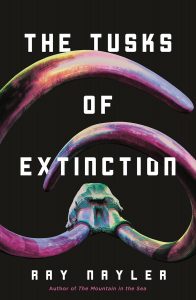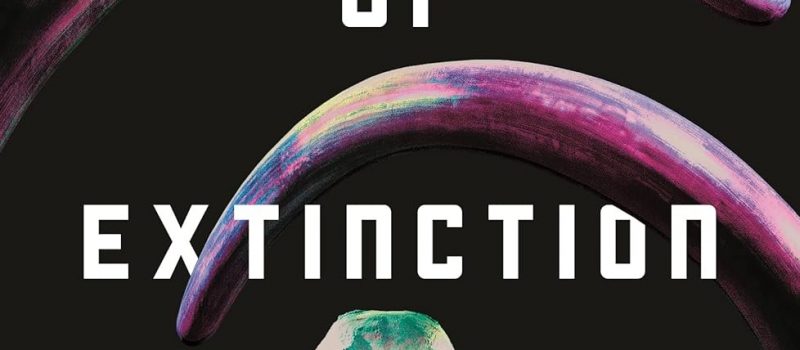Russell Letson Reviews The Tusks of Extinction by Ray Nayler
 The Tusks of Extinction, Ray Nayler (Tordotcom 978-1-25085-552-7, $26.99, 101pp, hc) January 2024. Cover by Faceout Studios.
The Tusks of Extinction, Ray Nayler (Tordotcom 978-1-25085-552-7, $26.99, 101pp, hc) January 2024. Cover by Faceout Studios.
It is a proposition universally asserted that the novelette and novella are the optimal lengths for science fiction. Or frequently suggested, anyway, despite the number of five-volume trilogies and long-running series out there. And the relatively recent renaissance of small-press operations has certainly given freestanding midlength work renewed visibility outside the pages of the surviving magazines.
I suppose one appeal of the novella is that it offers more space than a short story does for speculative material – “ideas” – to spread out and for implications to be pursued, for processes and procedures to be outlined and backgrounds to be filled in. I noticed all of that in Ray Nayler’s The Tusks of Extinction, which depends for many of its effects on the confluence of two big enabling devices: the resurrection of an extinct species and personality/memory recording and reimplantation. And this novella also has the elbow room to present not only its future, but a complex and compelling novelistic consideration of familial, cultural, political, and ecological matters – in short, a vision of the interrelationships that make a world.
The pulpish title implies melodrama, and the story’s present action certainly does involve violence, retribution, and wilderness adventure. More than a century from now, woolly mammoths have been recreated and set loose in a vast Siberian preserve, but they are still subject to covertly approved trophy-hunting by the obscenely wealthy and to absolutely illegal slaughter by ivory poachers. Nor are those the only threats they face: Since the resurrected animals did not initially have the survival skills that their predecessors developed and shared socially, they do not know how to be mammoths. The solution was to install in one mammoth matriarch the recorded memories and personality of Damira Khismatullina, a long-dead human specialist in elephant behavior and culture who could teach her herd the skills it needs to flourish on the tundra. But the threat of human predation remains, and the story shuttles between the actions and attitudes of mammoth-Damira and those who would kill members of her herd for their enormously valuable tusks.
That present action is intertwined with multiple backstories: of hunters, poachers, and especially of the reawakened and reconfigured Damira, who dedicated (and lost) her life to the fight against elephant poachers in Africa a century earlier. The book opens with alternating present and antecedent action: as mammoth-Damira discovers a pair of slaughtered mammoths, she recalls her human life and her work with Kenyan park rangers. Eventually, her memory passages track back to her childhood in Russia, to the recording of her personality, and to the eventual murders of her team by highly organized poachers. (Her own murder, of course, she does not recall.)
This present/past pattern continues with the rest of the viewpoint characters. On the other side of the hunter-hunted divide, teenaged Svyatoslav is reluctantly following his father’s poaching trade and remembering the borderline poverty and the drunken disorder that filled it. Other hunters occupy the apex of the social scale: Vladimir accompanies his billionaire husband Anthony on a quasi-legal bought-and-paid-for expedition to bag a mammoth – but Vladimir has no sense of connection to the land his grandparents left behind and would not even talk about.
Taken together, these backstories build a portrait of conservation, exploitation, desperation, and the callous folly of humankind’s relationship with the nonhuman world – a thematic foreground that outlines the economics and politics of preservation and poaching. But it also opens out into an even larger moral vision of connections, of ecologies and economies, of belonging, of being from somewhere, often as signaled by memory (which connects present to past). Damira recalls the childhood gift of a stuffed toy elephant, a “clumsy thing… designed by people who had never seen, in their lives, many of the animals they were imitating,” which nevertheless was the beginning of her fascination with elephants. Svyatoslav remembers the maps his mother showed him, and that sense of geographical connection eventually tells him that there are paths out of the dead-end horrors of poaching. And there are less healthy kinds of connection – or disconnection. Damira’s colleague, the Kenyan ranger Wamugunda, recalls how he came to see cities as
vortexes into which the currents of trade accelerated, into which goods from all over the world were pulled. Places where things became materials. Where things became commodities. And on the other end of all that, the places people like me were from – the extraction zones where the tug of all this displacement began…. I saw everything that was torn from its natural environment to become a material, to become anonymous, denatured.
In its braiding of associations, the novella operates poetically, drilling down through the layers of mere greed, of poverty and the drunken brutality of damaged or deracinated personalities, of the pathological need to kill, to deeper layers of connection to or estrangement from the natural world, of extraction and exploitation and commodification – and preservation. Like the material-world ecology that the mammoths support, or the extractive economies that loot and exploit the world’s ecosystems; or the web or memories that constitute personhood, Nayler’s story unpacks, if not forgives, the forces and influences that lead to particular life choices or traps. “Only connect,” indeed.
Russell Letson, Contributing Editor, is a not-quite-retired freelance writer living in St. Cloud MN. He has been loitering around the SF world since childhood and been writing about it since his long-ago grad school days. In between, he published a good bit of business-technology and music journalism. He is still working on a book about Hawaiian slack key guitar.
This review and more like it in the March 2024 issue of Locus.
 While you are here, please take a moment to support Locus with a one-time or recurring donation. We rely on reader donations to keep the magazine and site going, and would like to keep the site paywall free, but WE NEED YOUR FINANCIAL SUPPORT to continue quality coverage of the science fiction and fantasy field.
While you are here, please take a moment to support Locus with a one-time or recurring donation. We rely on reader donations to keep the magazine and site going, and would like to keep the site paywall free, but WE NEED YOUR FINANCIAL SUPPORT to continue quality coverage of the science fiction and fantasy field.
©Locus Magazine. Copyrighted material may not be republished without permission of LSFF.







